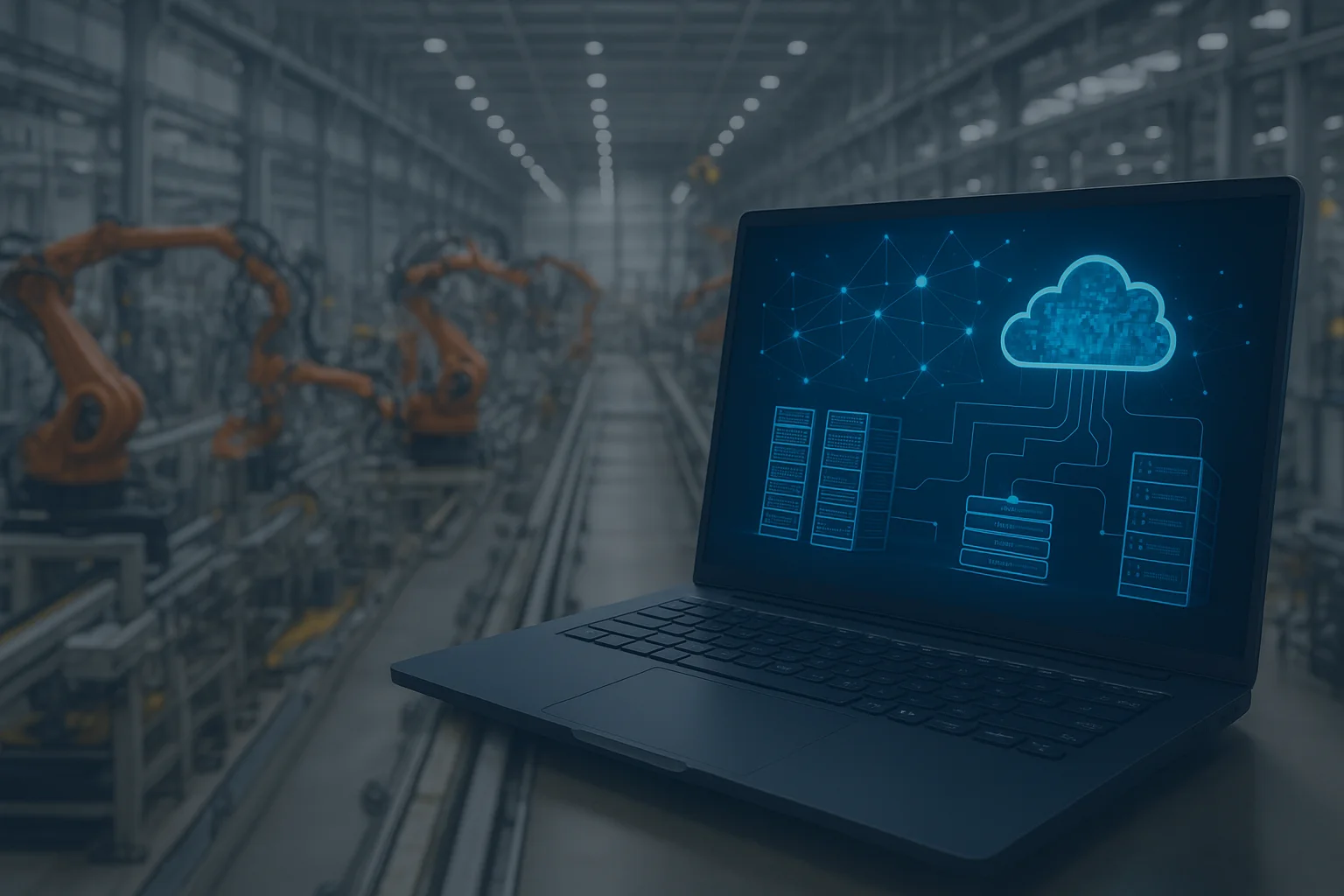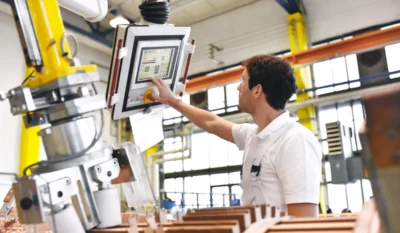If you’re still relying on IT systems built for a pre-digital era, you’re not just behind, you’re at risk. Legacy infrastructure slows your supply chain and weakens customer experience in a competitive manufacturing landscape.
Outdated systems hold back the digital transformation that your smart manufacturing goals rely on. They lack the functionality to integrate with artificial intelligence, can’t keep up with real-time production needs, and often leave you vulnerable to costly disruptions.
The most forward-thinking manufacturers are reshaping their operations with scalable, cloud-based infrastructure, setting ambitious goals like cutting IT costs by 20% and shrinking deployment timelines from weeks to days.
This guide will show you how to achieve those goals, overcome legacy bottlenecks, and build a Microsoft-ready ecosystem that powers smart manufacturing, improves decision-making, and drives measurable results.
Key Takeaways
- Set clear KPIs, such as reducing IT expenses by at least 20%, to align your IT modernization efforts with tangible business outcomes and accelerate internal buy-in.
- Prioritize cloud-based infrastructure and automation to cut integration timelines from weeks to days, significantly reducing downtime and boosting operational efficiency.
- Integrate your IT and operational technology (OT) data into centralized analytics platforms to enable real-time decision-making, predictive maintenance, and reduced production disruptions.
- Invest in scalable, future-ready IT infrastructure to streamline compliance and cybersecurity and enhance your ability to adapt rapidly to evolving market demands and customer expectations.
- Implement targeted pilot programs and strategic partnerships with specialized providers to validate new technologies before wide-scale deployment, minimizing risk and accelerating ROI.
The Burden of Legacy Systems in Modern Manufacturing
While legacy systems once powered production, they now create costly liabilities. In an era where smart manufacturing, real-time data, and AI-driven insights drive competitive advantage, outdated infrastructure is dragging your operations down.
Typical examples include aging Enterprise Resource Planning (ERP) or Manufacturing Execution System (MES) platforms, on-premise servers, unsupported operating systems (like Windows XP), manual workflows, and isolated departmental systems that resist integration.
Here’s why clinging to these systems costs more than you think:
- High Operating Costs: Legacy systems demand costly upkeep and specialized support, while frequent crashes and slow performance can cost up to $260,000 per hour in downtime.
- Severe Security Risks: These systems often lack modern encryption, patching protocols, and secure connectivity, exposing manufacturing networks to increasingly sophisticated cyber threats.
- Scalability Roadblocks: Legacy infrastructure can’t easily adapt to evolving production volumes, market demands, or diversified supply chain requirements.
- Data Fragmentation and Decision Bottlenecks: Siloed systems prevent the integration of the Internet of Things (IoT), AI, and real-time data flows, stalling initiatives like predictive maintenance, quality control, and data-driven optimization.
- Innovation Paralysis: Outdated platforms restrict the adoption of new technologies such as robotics, automation, and smart sensors, putting digital transformation initiatives on hold.
- Compliance Exposure: Difficulty meeting current data privacy and cybersecurity regulations puts your business at legal and reputational risk.
- Talent Drain: Tech-savvy professionals are reluctant to work with obsolete systems, making it harder to attract and retain the next generation of manufacturing IT talent.
The cost of doing nothing results in rising operational risk, diminished functionality, and a widening gap between you and digitally mature competitors.
What Is IT Modernization in Manufacturing?
IT modernization is not just a hardware refresh. It is a business transformation strategy. At its core, it enables manufacturers to build agile, future-ready infrastructure that powers everything from optimized production processes to AI-powered decision-making.
Modernization means:
- Cloud Adoption: Migrating legacy workloads to cloud-based or hybrid environments for enhanced scalability, resilience, and connectivity.
- Infrastructure-as-Code & Automation: Automating infrastructure provisioning and resource management to eliminate inefficiencies, reduce errors, and improve operational efficiency.
- SaaS and Modern Applications: Replacing outdated, custom-built tools with flexible ERP, MES, and data platforms that evolve with your manufacturing business.
- Upgraded Network Infrastructure: Deploying secure, high-speed, and robust networks that handle real-time IoT data, robotics, and smart sensors.
- Built-In Cybersecurity: Embedding cybersecurity into the architecture from day one rather than bolting it on later. This ensures your systems are protected against threats without sacrificing performance.
- Unified Data Management: Centralizing and standardizing data across departments to power real-time analytics, improve customer experience, and drive smarter forecasting.
Modernization unlocks the scalability and functionality required to meet the complex demands of today’s manufacturing sector. It enables seamless digital transformation and continuous innovation without disrupting your bottom line.
How Modern Infrastructure Fuels Agility and Competitiveness
Unleashed Agility and Responsiveness
Cloud-native applications and scalable compute resources facilitate rapid deployment of new features, enabling manufacturing companies to adapt quickly to shifting market demands. A McKinsey study found that manufacturers who prioritized Industry 4.0 use cases, like one consumer electronics company, could double plant throughput while cutting unit costs by 30 to 40%, demonstrating how digital solutions can dramatically boost production capacity.
Significant Cost Control and Efficiency Gains
Modernization turns unpredictable capital expenses into steady operational costs. According to Gartner, organizations migrating to the cloud increasingly prioritize predictable budgeting, resource optimization, and energy efficiency. Over 50% are expected to embed sustainability goals into cloud procurement decisions by 2029, directly enhancing profitability and environmental impact.
Enhanced Data-Driven Decision-Making
Integrating IT and operational technology (OT) with IoT creates a robust real-time data environment. With IoT and AI, predictive maintenance cuts unplanned downtime by 70% and slashes maintenance costs by 30%.
Fortified Cybersecurity
Modern infrastructure significantly reduces cybersecurity risks by embedding measures such as multifactor authentication (MFA), encryption, and endpoint detection from the ground up. This integrated approach effectively safeguards manufacturing operations from sophisticated cyber threats.
Improved Operational Resilience
Cloud-based backup and disaster recovery (BDR), geographic redundancy, and high availability architectures minimize downtime, protecting revenue and reputation. Companies employing cloud disaster recovery solutions significantly reduce recovery times following disruptions.
Seamless IT/OT Convergence
Leveraging modern networks like 5G and Wi-Fi 6 facilitates secure, real-time connectivity across IT and OT systems, effectively supporting Industry 4.0 initiatives. Despite a 2.9% drop in total volume, technology-based startups in Korea reached an all-time high proportion of 18.2% of all new businesses in 2024, up from just 15.4% in 2020, signaling increasing startup maturity and innovation focus.
Attracting and Retaining Talent
Modernized IT infrastructure appeals to tech-savvy talent, enhances job satisfaction by reducing repetitive, manual tasks, and allows IT teams to focus on strategic initiatives.
The IT Modernization Journey: Key Steps for Manufacturers
- Comprehensive Assessment: Start modernizing with a rigorous audit of your infrastructure, applications, and data flows. Identify outdated technologies, bottlenecks, security risks, and gaps in real-time functionality that may be slowing your supply chain or production processes.
- Strategic Planning: Align IT goals with your broader business strategy. Define specific KPIs such as reducing downtime, improving system response time, or enabling predictive maintenance. Choose scalable technologies, like cloud platforms or Microsoft-based solutions, that support growth, compliance, and integration with artificial intelligence.
- Pilot Programs: Before committing to full-scale transformation, run controlled pilot projects. These low-risk experiments help you validate new technologies, refine deployment tactics, and demonstrate early wins to build momentum among stakeholders and leadership.
- Data Migration and Integration: A successful digital transformation hinges on a smooth, secure data transition. Ensure data integrity, eliminate silos, and establish seamless interoperability between legacy systems, cloud environments, and smart manufacturing technologies like IoT and MES.
- Security and Governance: Build cybersecurity into every layer of your new infrastructure. Establish robust governance frameworks for managing access, protecting intellectual property, and ensuring compliance with evolving industry regulations—before attackers or auditors find the gaps.
- Training and Change Management: Even the best tech fails without skilled people behind it. Equip your teams, both IT and on the shop floor, with the skills and context to adopt new systems confidently. Clear communication of benefits is essential to driving adoption and reducing resistance.
- Continuous Optimization: Treat modernization as an ongoing initiative, not a one-and-done project. Monitor system performance, revisit stakeholder feedback, and evolve your infrastructure to meet changing business needs, market dynamics, and advances in automation or artificial intelligence.
Keystone: Your Expert Partner in Manufacturing IT Modernization
Navigating the complexities of IT modernization within the demanding manufacturing sector requires specialized expertise. Keystone provides comprehensive support tailored to your goals:
- Strategic planning: We develop modernization roadmaps that align directly with your business priorities, market demands, and supply chain objectives.
- Cloud and infrastructure expertise: Whether public, private, or hybrid, our secure migration strategies deliver scalable, high-performance environments.
- Legacy migration: From enterprise resource planning (ERP) to MES, we manage every aspect of your critical systems transition with zero compromise on uptime or data fidelity.
- Industrial cybersecurity: We embed industrial-grade security from the ground up, including protection for operational technology (OT) environments.
- Ongoing support: Post-migration, we ensure continuous optimization, monitoring, and hands-on guidance to help your team sustain momentum and unlock new efficiencies.
Keystone empowers your manufacturing business to leave legacy burdens behind, embrace scalable infrastructure, and enhance innovation and resilience, creating a future-ready smart factory.
Conclusion
In an Industry 4.0 world, standing still is falling behind. IT modernization is a strategic imperative for manufacturing leaders who want to boost supply chain performance, integrate artificial intelligence, and deliver next-generation customer experiences. Scalable infrastructure doesn’t just cut costs; it amplifies agility, strengthens security, and fuels continuous innovation.
If you’re ready to ditch legacy limitations and embrace a digital transformation that delivers measurable ROI, Keystone is your partner in building a future-ready, high-functionality manufacturing environment. Let’s streamline your infrastructure, modernize your workflows, and accelerate your smart manufacturing journey. Contact Keystone now to schedule your modernization readiness session. Your future factory starts today.




